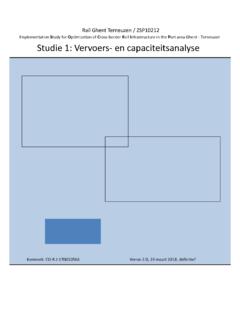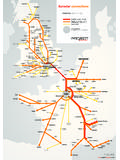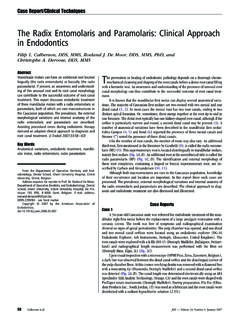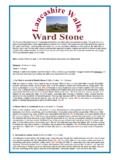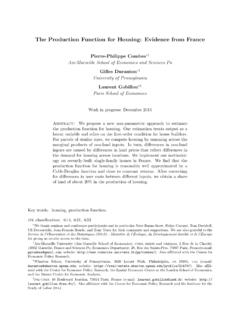Transcription of Permanent and Temporary Grassland Plant, Environment and ...
1 3-5 September 2007 Permanent and Temporary Grassland Plant, Environment and Economy Edited by A. De Vliegher L. Carlier VOLUME 12 Grassland SCIENCE IN EUROPE Foreword Grassland as a whole and especially natural Grassland covers a big part of the European territory. In some countries with large mountain areas, Permanent Grassland covers more than half of the land used for agricultural purposes. However, sometimes it is not very clear what is meant by the term Permanent pasture in comparison with Temporary Grassland . The European Commission defines Permanent pasture as land used to grow grasses or other herbaceous forage naturally (self seeded) or through cultivation (sown) and that has not been included in the crop rotation of the holding for five years of longer (Commission Regulation (EC) No 796/2004).
2 This already gives us, as Grassland researchers matter for reflection and conversation. In easily convertible soils ( Flanders, the Netherlands, UK, Denmark, Germany, West-France) with a moderate climate farmers are used to renovating their Grassland regularly and incorporating it in their farm production scheme. Sometimes Grassland -for grazing conditions during summer time- and maize -growing for winter stable feeding- are the only crops on dairy or beef production farms. Permanent pastures with a good botanical composition have the advantage to permanently cover the soil with a positive effect on production, C storage, capturing minerals and nitrate nitrogen, erosion On the other hand regularly renovated Grassland and Temporary Grassland gives the opportunity to introduce the newest developed varieties of good and well adapted grass species on the farm.
3 Breeding always creates new varieties with specific characteristics for a better production and/or quality, an improved resistance against diseases, biotic and abiotic stress frost, draught, .. Do we have to pay special attention to our Grassland in the next decades because of global warming ? Will softer and wetter winters combined with drier and hotter summers constraint the production capacity of Grassland and how will Grassland compete with other forages? The proceedings of this symposium contain 133 papers and all the abstracts of papers and posters are summarized in a special booklet. We will overlook the item of the symposium in three sessions. During the mid conference tours the participants get some information on Flemish Grassland farming and during the post conference tours we will pay special attention to the more natural Grassland in the Walloon Provinces.
4 We would like to seize the opportunity to thank numerous people for their help in the organisation of this symposium and the publishing of this book: the members of the Organizing and Scientific Committees, the external reviewers, etc. We wish all of you a nice stay in Gent and a fruitful participation to this 14th international symposium of the EGF at the headquarters of the Faculty of Bioscience Engineering of Gent University. Lucien Carlier Alex De Vliegher President of the organizing committee Secretary of the organizing committee Opening Session The comparison between Temporary and Permanent Grassland Reheul , De Vliegher , Bommel and Carlier 1 University of Gent, Department of Plant Production, Coupure links 653, BE-9000 Gent 2 ILVO, Plant Crop Husbandry and Environment , Burg.
5 Van Gansberghelaan 109 box 1, BE-9820 Merelbeke, Belgium Abstract An overview is given of definitions and importance of Temporary and Permanent Grassland in Europe. Problems and opportunities of Temporary Grassland in comparison with Permanent Grassland are summarised for seed mixtures, dry matter yield, clover content and residual soil nitrogen. A good sward should never be turned down. If old swards are to be turned down the best option is to start an arable period with the establishment of N greedy crops. If new swards are necessary the best option is to establish them in arable land. If swards really need to be re-established the application of a cutting regime prevents potential N leaching. 1. Introduction When Sir Richard Weston travelled from England to Belgium in 1644 he went from one sursprise to the next.
6 In his Discours of husbandrie used in Babant and Flanders , edited in 1650 he gives his impression on the quality of the land and its management between Dunkerque (now France) and Antwerpen. Between Dunkerque and Brugge he saw a prosperous wealthy land, covered with wheat, barley and meadows. Half way between Brugge and Gent, he noticed, the quality of the land became poorer. Seen from the main roads between Gent and Antwerpen he saw very poor heathland, reminding him on his own land back in England. In Gent he met a Dutch merchant who told him that farmers living in the poor land between Gent and Antwerp were by far the richest farmers of Flanders. Weston thaught the Dutchman was joking, but he was not. Another Dutchman introduced and brought him to some succesful farmers where he found out the origin of the wealth.
7 The Flemish farmers applied a specific crop rotation when exploiting the heathland. As a first crop they grew flax, immediately followed by turnips. The next year they installed oats, undersown with grass-clover which they kept for up to five years. The clover was very likely red clover but after five years evolution it was replaced spontaneously by white clover. With this crop rotation the farmers earned more money1 than those growing cereals and meadows on the fertile sandy loam soils between Dunkerque and Brugge. 2. Definition of Temporary and Permanent Grassland In the EU Permanent Grassland is defined as follows: land used to grow grasses or other herbaceous forage naturally (self-seeded) or through cultivation (sown) and that is not included in the crop rotation of the holding for five years or longer (Commission Regulation EU No 796/2004).
8 Before the EU definition, Permanent Grassland was defined in vague terms. It was an area with grass as a continuous crop for a relatively long to very long time, with or without resowing. The EU needed a clear and simple definition of Permanent Grassland in the 1 At that time an acre of barley had a value of 10-12 pounds, an acre of wheat 5-6 pounds, an acre of flax 40-50 pounds, an acre of grass-clover 10-12 pounds and an acre of turnips 8-10 pounds. Permanent and Temporary Grassland : plant, Environment and economy 1 framework of their subsidization policy but for some farmers it feels strange to call Grassland Permanent when it is only 5 years of age. In official statistics about agriculture, the area of Permanent Grassland is restricted to the area which is used for grazing and/or cutting, even when the management is very extensive.
9 A ley is an area of land where grass is grown temporarily instead of crops (Oxford Dictionary). Temporary Grassland is a typical crop in the Atlantic part of Europa and in southern Scandinavia. The EU definition of Temporary Grassland is Grassland less than 5 years of age, included in a crop rotation. Before the EU definition, Temporary Grassland was defined as sown Grassland included in a crop rotation . Depending on the country, it lasted for a very short time or for a longer period (Table 1). In Denmark this type of Grassland is managed for about 2-4 years and in Ireland for at least 4 years but usually for a much longer period. In the Mediterranean area the term Temporary Grassland is not in use but replaced by artificial Grassland containing wheat/ barley or some grasses due to be grazed during 1 or 2 seasons respectively.
10 3. Facts and figures on Temporary and Permanent Grassland in Europe Approximately half of the European Union s land is farmed, highlighting the importance of agriculture in the society. Utilised agricultural area (UAA) in EU is defined as the area taken by arable land, Permanent Grassland , Permanent crops ( vineyards) and kitchen gardens. Permanent Grassland covers 32% of the UAA with important differences between the member states (Table 2). France, UK and Spain have over 7 million of hectares of Permanent Grassland . In the UK, Ireland and Slovenia Permanent Grassland covers at least 60% of the UAA. Eurostat and many national statistics allocate Temporary Grassland (<5 years) to arable land. There is no overview of the Temporary Grassland area available in Eurostat.
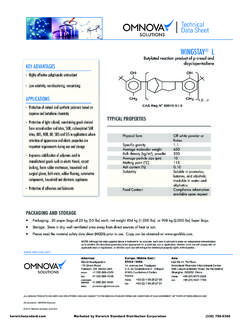
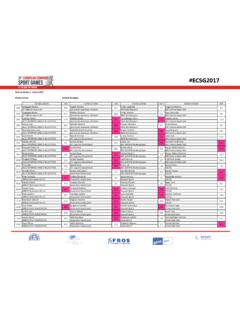
![[Chem²ath Contest Chemistry Questions] - Ghent](/cache/preview/7/7/3/c/6/a/b/3/thumb-773c6ab3f316a02aeb943501e4c2b967.jpg)
